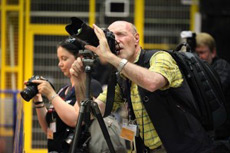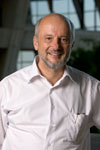|
Have a safe day!
Tuesday, Sept. 28
10:30 a.m.
Research Techniques Seminar
- Curia II
Speaker: Albert Young, North Carolina State University
Title: Neutron-Antineutron Oscillation Measurements Using Cold and Ultracold Neutrons
4 p.m.
Accelerator Physics and Technology Seminar - One West
Speaker: Vladimir Shiltsev, Fermilab
Title: Accelerators as High Precision Seismometers, Tunnel and Orbit Drifts in the Tevatron, and the ATL Law of Ground Diffusion in Space and Time
Wednesday, Sept. 29
3:30 p.m.
DIRECTOR'S COFFEE BREAK - 2nd Flr X-Over
4 p.m.
Fermilab Colloquium - One West
Speaker: Joerg Jaeckel, Durham University
Title: Fundamental Physics at Low Energies
Click here for NALCAL,
a weekly calendar with links to additional information.
Upcoming conferences |
|
Tuesday, Sept. 28
- Breakfast: Bagel sandwich
- Creamy turkey vegetable soup
- Chili dog
- Country-fried steak
- Chicken cacciatore
- Italian panini w/ provolone
- Assorted sliced pizza
- Super burrito
Wilson Hall Cafe Menu
|
|
Wednesday, Sept. 29
Lunch
- Brandy-pork tenderloin
- Cauliflower gratin
- Cinnamon apple crisp
Thursday, Sept. 30
CLOSED
Chez Leon Menu
Call x3524 to make your reservation. |
|
|
Vote for top Particle Physics Photowalk photograph
 |
| At the 2010 Particle Physics Photowalk, more than 200 photographers had the rare opportunity to experience state-of-the-art accelerators and detectors in all of their complexity and beauty. |
On August 7, more than 200 photographers had the rare opportunity to go behind the scenes at five laboratories in Asia, Europe and North America as part of the first Global Particle Physics Photowalk. Thousands of photographs were submitted to the laboratories for local and global competitions. The laboratories have made their choices, each nominating three photographs for global competition. Now it’s your turn – starting today, you may vote for up to three of your favorite photographs as part of the “people’s choice” global photowalk competition.
On the day of the big event, CERN in Geneva, Switzerland; DESY in Hamburg, Germany; Fermilab in Batavia, Illinois; KEK in Tsukuba, Japan; and TRIUMF in Vancouver, Canada, all opened their doors to photographers armed with cameras, lenses and hungry, hungry eyes. Each laboratory conducted its own local competition with panels of judges or tallying votes from laboratory staff. The winners are a diverse group, ranging from a high school student in Canada to a lead technician in a manufacturing company in Germany.
As a nature photographer and retired landscape designer, Chuck Peterson, a finalist who attended the photowalk at Fermilab, has a creative eye for juxtaposing nature with man-made objects. When presented with the rare opportunity to photograph the inner sanctum of a particle physics laboratory, he jumped right on board.
“Fermilab’s unique combination of natural areas and scientific research create very interesting juxtapositions in photography,” said Peterson, a resident of St. Charles, Illinois. “It is a fun site to photograph.”
Ali Lambert, a junior in high school from Vancouver, Canada, won the local competition at TRIUMF. She had never entered a photo contest before and spent last summer working as a receptionist to save up for her camera, now her most prized possession. “I really enjoy photographing the simple things that people usually take for granted,” she said.
Read more
|
First Observation of Hawking Radiation
From Technology Review , Sept. 27, 2010
For some time now, astronomers have been scanning the heavens looking for signs of Hawking radiation. So far, they've come up with zilch.
Today, it looks as if they've been beaten to the punch by a group of physicists who say they've created Hawking radiation in their lab. These guys reckon they can produce Hawking radiation in a repeatable unambiguous way, finally confirming Hawking's prediction. Here's how they did it.
Physicists have long realised that on the smallest scale, space is filled with a bubbling melee of particles leaping in and out of existence. These particles form as particle-antiparticle pairs and rapidly annihilate, returning their energy to the vacuum.
Hawking's prediction came from thinking about what might happen to particle pairs that form at the edge of a black hole. He realised that if one of the pair were to cross the event horizon, it could never return. But its partner on the other side would be free to go.
Read more
|
The Supernova's Secrets Cracked at Last?
From Time, Sept. 24, 2010
Most stars end their lives in a whimper — our own sun will almost certainly be one of them — but the most massive stars go out with an impressive bang. When that happens, creating what's known as a Type II supernova, the associated blast of energy is so brilliant that it can briefly outshine an entire galaxy, give birth to ultra-dense neutron stars or black holes, and forge atoms so heavy that even the Big Bang wasn't powerful enough to create them. If supernovas didn't exist, neither would gold, silver, platinum or uranium. The last time a supernova went off close enough to earth to be visible without a telescope, back in 1987, it made the cover of TIME.
Given the Type II supernovas' cosmic importance, you might think astronomers would have figured out how they work — and in a general way, they have. But when it comes to the most critical few moments of the detonation process, says Princeton theorist Adam Burrows, you'd be wrong. "We've been working on this for about 50 years," he explains, "but every time we think we've nailed it, the answer turns out to be ambiguous or wrong." (There's an entirely different kind of a supernova by the way, called a Type I, which astronomers don't fully understand either, but that's a different story.)
Thanks to a new, powerful supercomputer simulation, though, reported in the current Astrophysical Journal, Burrows and a group of colleagues at Princeton and Lawrence Berkeley National Laboratory, in California, are convinced they're getting closer. "We're not there yet," he says, "but victory is in sight."
Read more
|
|
|
An Open ES&H Culture
 |
| Fermilab Director Pier Oddone |
No one comes to work wanting or expecting an injury. When an injury does happen, looking at the “anatomy” of an event typically reveals latent organizational weaknesses, error precursors, flawed defenses and finally an initiating action that results in an injury or unintended outcome. This is why at Fermilab we invoke discipline in the case of an injury only in the rare situation when an investigation shows that the injured person blatantly disregarded Fermilab ES&H rules. Rather, we look deeper inside the process and attempt to understand what circumstances led to the event. We then take action and make changes to prevent a recurrence.
We do not want a culture where individuals are afraid to report injuries, error precursors or other job site issues. The ES&H program relies on communication throughout our organization, and reporting injuries or other ES&H issues is critical to creating a safe work environment. Without your input the system fails. At the end of the day, nothing is more important than going home safe and sound.
As a result of a recommendation from the Director’s Panel on Injury Reduction, and to promote an open safety culture where all employees are confident that any issues brought forth will result in a better workplace, Fermilab has been using Human Performance Improvement principles for a number of years.
What is HPI? The purpose of Human Performance Improvement is to minimize the frequency and severity of accidents that result in injury to workers, damage to equipment or damage to the organization. HPI is a systematic process for discovering and analyzing human performance gaps and taking corrective actions to minimize or eliminate these gaps. The program also evaluates these results and feeds the information back into our work processes. HPI is a powerful approach because it deals not only with individual and team behaviors, but also seeks to understand organizational and workplace factors that influence those behaviors. The Institute of Nuclear Power Operations found that 75 to 80 percent of their injuries and incidents happened because of human error. Of these, 70 percent were attributable to organizational weaknesses that influenced the human error. For more than a decade, INPO has used HPI to reduce both the frequency and severity of events in the commercial nuclear power industry.
FESS has implemented HPI in many of their work processes. This has led to more open and candid discussions at all levels of the organization, strengthening work procedures and resulting in improved safety and efficiency. They openly discuss potential problems they might encounter due to various error precursors - working when tired or at night, or on multiple processes, for example – and look for ways to improve equipment or procedures ahead of time to minimize the likelihood of a mistake that could lead to injury or a poor job.
We look forward to a complete implementation of HPI in other organizations at Fermilab in the near future.
|
|